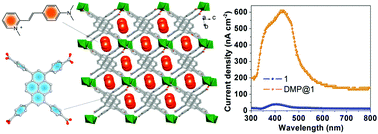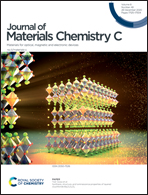Highly enhanced UV-vis-NIR light harvesting and photoelectric conversion of a pyrene MOF by encapsulation of the D–π–A cyanine dye†
Abstract
The development of photofunctional metal–organic frameworks (MOFs) has received increasing attention owing to their adjustable molecular assembly modes and broad optoelectronic applications. However, efficient wide-range solar energy utilization and conversion of such materials remain scarce. Herein, an anionic pyrene-based MOF [(HOEtMIm)2][Mn3(TBAPy)2(μ2-OH2)2(H2O)2] (1) (H4TBAPy = 1,3,6,8-tetrakis(p-benzoic acid)-pyrene) was synthesized under ionothermal conditions. Through a facile ion exchange process, D–π–A cation dye cyanine (DMP) was successfully encapsulated into nanochannels of MOFs, forming molecular level heterojunctions of a DMP@1 donor–acceptor system. The emission color of 1 was largely modulated from cyan to orange through Förster resonance energy transfer as confirmed by both experiments and theoretical calculations. Moreover, the obtained DMP@1 shows a distinct light absorption from the UV/visible to the NIR region, and extremely high luminescence polarization anisotropy (0.97) due to the regular orientation and orderly arrangement of the linear DMP into the MOF host. Photoelectric measurements show that the photocurrent of DMP@1 is at least 15 times higher than that of 1 under monochromatic light.

- This article is part of the themed collection: Journal of Materials Chemistry C HOT Papers


 Please wait while we load your content...
Please wait while we load your content...